Risk Management: Piper Alpha Explosion and Prevention Strategies
VerifiedAdded on 2021/05/31
|11
|2841
|38
Report
AI Summary
This report delves into the critical aspects of risk management, emphasizing its importance in preventing accidents within organizations. The report begins by defining risk management and safety management, highlighting the significance of proactive measures to mitigate potential hazards. It uses the Piper Alpha oil and gas platform explosion as a case study, illustrating how negligence and a lack of risk management strategies can lead to catastrophic consequences. The report then outlines key risk management features, including comprehensive risk assessments, fostering a robust safety culture, conducting regular safety audits, adhering to rules and regulations, promoting a healthy work-life balance, ensuring proper equipment maintenance, providing adequate training, defining clear responsibilities, implementing effective job coordination, and conducting safety drills. Each feature is discussed in detail, with examples of how they can be applied to prevent accidents. The report concludes by reiterating the importance of these features in minimizing the impact of accidents and emphasizes the need for a proactive and comprehensive approach to risk management to protect both employees and stakeholders. The report also discusses how the application of these features could have prevented the Piper Alpha disaster by focusing on the specific failures that led to the explosion, such as equipment maintenance, lack of coordination and communication, and insufficient training. The report highlights the importance of a safety culture, regular checks, and following safety protocols to prevent similar tragedies in the future.

Running Head: RISK MANAGEMENT 1
Risk Management
Names
Institution
Risk Management
Names
Institution
Paraphrase This Document
Need a fresh take? Get an instant paraphrase of this document with our AI Paraphraser
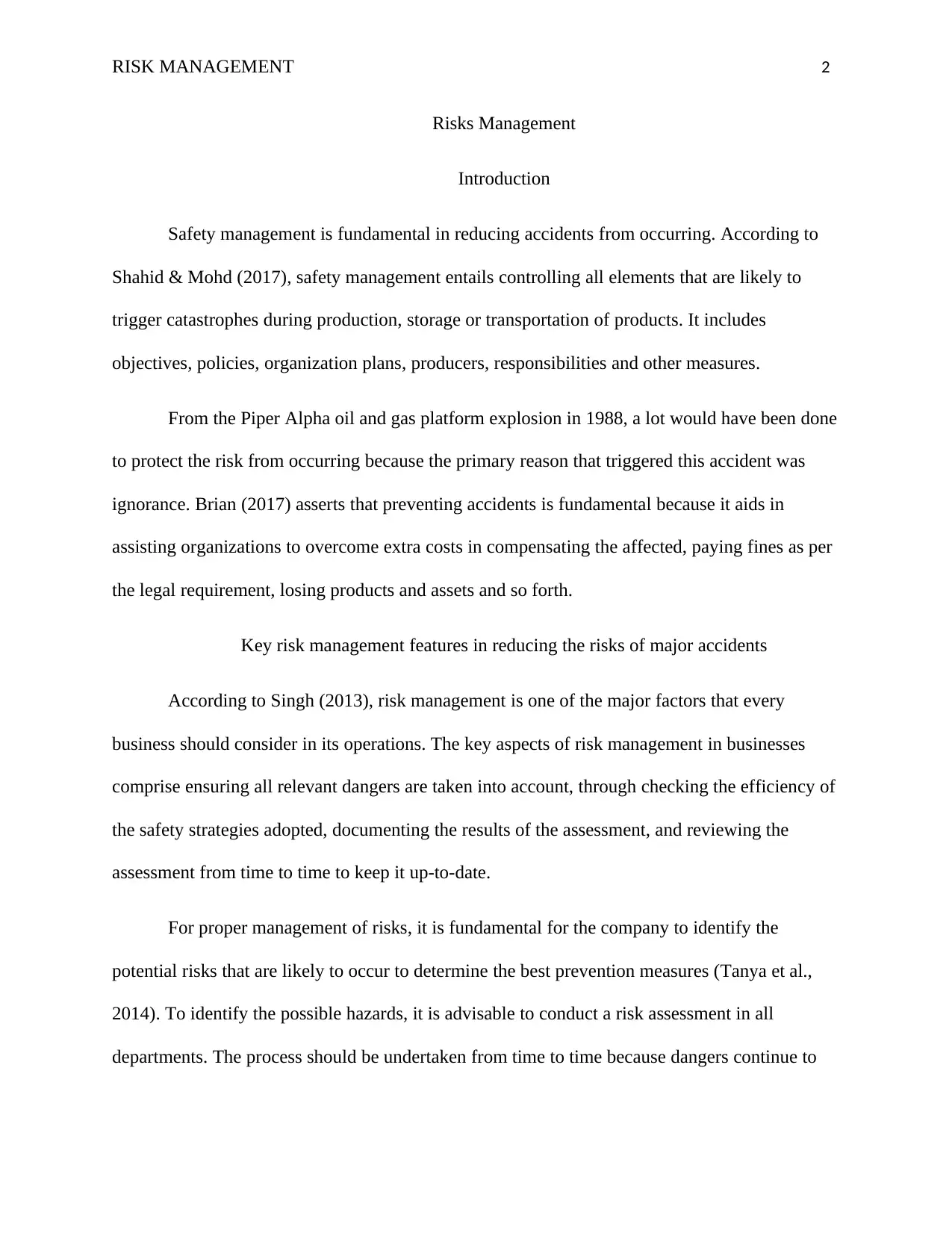
RISK MANAGEMENT 2
Risks Management
Introduction
Safety management is fundamental in reducing accidents from occurring. According to
Shahid & Mohd (2017), safety management entails controlling all elements that are likely to
trigger catastrophes during production, storage or transportation of products. It includes
objectives, policies, organization plans, producers, responsibilities and other measures.
From the Piper Alpha oil and gas platform explosion in 1988, a lot would have been done
to protect the risk from occurring because the primary reason that triggered this accident was
ignorance. Brian (2017) asserts that preventing accidents is fundamental because it aids in
assisting organizations to overcome extra costs in compensating the affected, paying fines as per
the legal requirement, losing products and assets and so forth.
Key risk management features in reducing the risks of major accidents
According to Singh (2013), risk management is one of the major factors that every
business should consider in its operations. The key aspects of risk management in businesses
comprise ensuring all relevant dangers are taken into account, through checking the efficiency of
the safety strategies adopted, documenting the results of the assessment, and reviewing the
assessment from time to time to keep it up-to-date.
For proper management of risks, it is fundamental for the company to identify the
potential risks that are likely to occur to determine the best prevention measures (Tanya et al.,
2014). To identify the possible hazards, it is advisable to conduct a risk assessment in all
departments. The process should be undertaken from time to time because dangers continue to
Risks Management
Introduction
Safety management is fundamental in reducing accidents from occurring. According to
Shahid & Mohd (2017), safety management entails controlling all elements that are likely to
trigger catastrophes during production, storage or transportation of products. It includes
objectives, policies, organization plans, producers, responsibilities and other measures.
From the Piper Alpha oil and gas platform explosion in 1988, a lot would have been done
to protect the risk from occurring because the primary reason that triggered this accident was
ignorance. Brian (2017) asserts that preventing accidents is fundamental because it aids in
assisting organizations to overcome extra costs in compensating the affected, paying fines as per
the legal requirement, losing products and assets and so forth.
Key risk management features in reducing the risks of major accidents
According to Singh (2013), risk management is one of the major factors that every
business should consider in its operations. The key aspects of risk management in businesses
comprise ensuring all relevant dangers are taken into account, through checking the efficiency of
the safety strategies adopted, documenting the results of the assessment, and reviewing the
assessment from time to time to keep it up-to-date.
For proper management of risks, it is fundamental for the company to identify the
potential risks that are likely to occur to determine the best prevention measures (Tanya et al.,
2014). To identify the possible hazards, it is advisable to conduct a risk assessment in all
departments. The process should be undertaken from time to time because dangers continue to
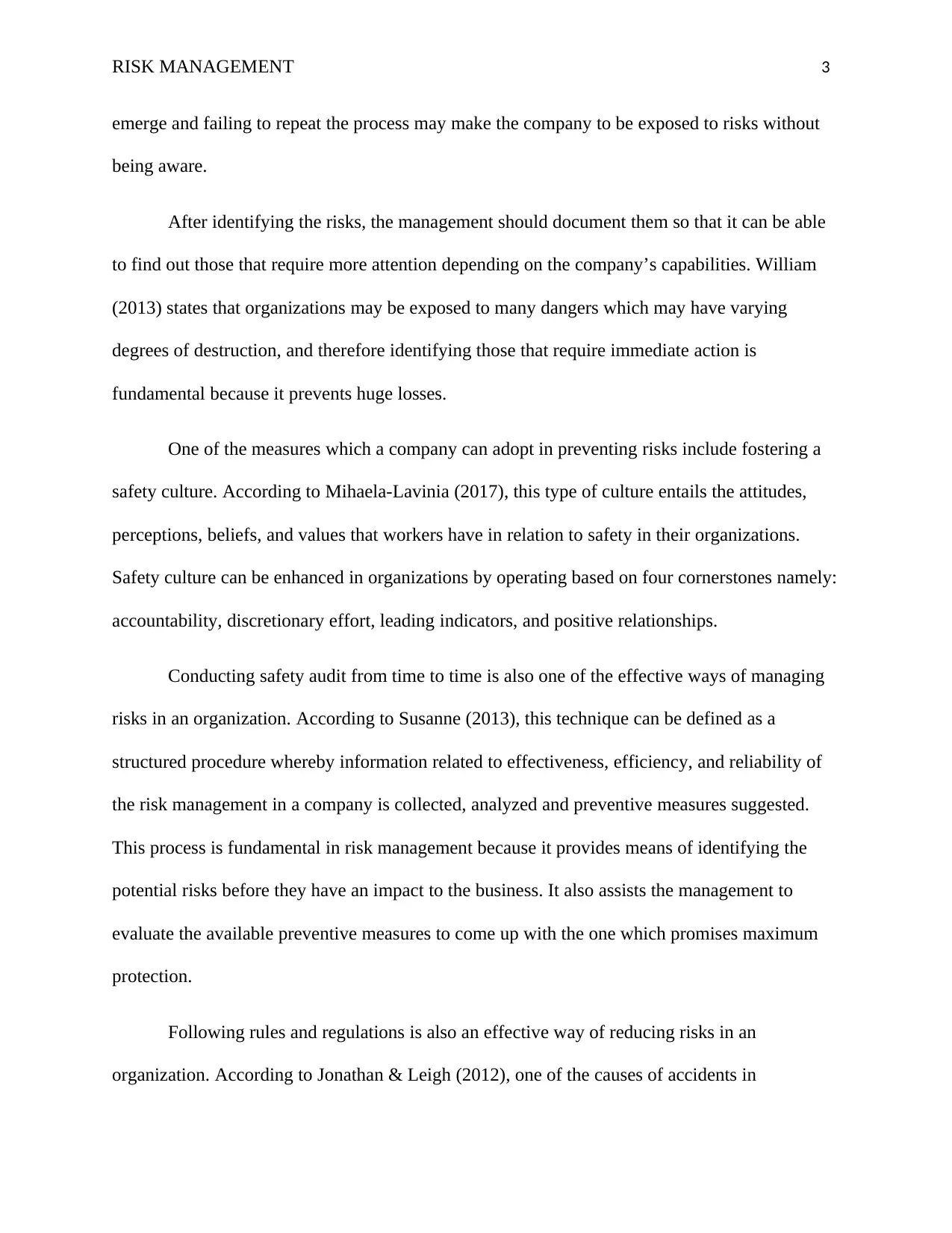
RISK MANAGEMENT 3
emerge and failing to repeat the process may make the company to be exposed to risks without
being aware.
After identifying the risks, the management should document them so that it can be able
to find out those that require more attention depending on the company’s capabilities. William
(2013) states that organizations may be exposed to many dangers which may have varying
degrees of destruction, and therefore identifying those that require immediate action is
fundamental because it prevents huge losses.
One of the measures which a company can adopt in preventing risks include fostering a
safety culture. According to Mihaela-Lavinia (2017), this type of culture entails the attitudes,
perceptions, beliefs, and values that workers have in relation to safety in their organizations.
Safety culture can be enhanced in organizations by operating based on four cornerstones namely:
accountability, discretionary effort, leading indicators, and positive relationships.
Conducting safety audit from time to time is also one of the effective ways of managing
risks in an organization. According to Susanne (2013), this technique can be defined as a
structured procedure whereby information related to effectiveness, efficiency, and reliability of
the risk management in a company is collected, analyzed and preventive measures suggested.
This process is fundamental in risk management because it provides means of identifying the
potential risks before they have an impact to the business. It also assists the management to
evaluate the available preventive measures to come up with the one which promises maximum
protection.
Following rules and regulations is also an effective way of reducing risks in an
organization. According to Jonathan & Leigh (2012), one of the causes of accidents in
emerge and failing to repeat the process may make the company to be exposed to risks without
being aware.
After identifying the risks, the management should document them so that it can be able
to find out those that require more attention depending on the company’s capabilities. William
(2013) states that organizations may be exposed to many dangers which may have varying
degrees of destruction, and therefore identifying those that require immediate action is
fundamental because it prevents huge losses.
One of the measures which a company can adopt in preventing risks include fostering a
safety culture. According to Mihaela-Lavinia (2017), this type of culture entails the attitudes,
perceptions, beliefs, and values that workers have in relation to safety in their organizations.
Safety culture can be enhanced in organizations by operating based on four cornerstones namely:
accountability, discretionary effort, leading indicators, and positive relationships.
Conducting safety audit from time to time is also one of the effective ways of managing
risks in an organization. According to Susanne (2013), this technique can be defined as a
structured procedure whereby information related to effectiveness, efficiency, and reliability of
the risk management in a company is collected, analyzed and preventive measures suggested.
This process is fundamental in risk management because it provides means of identifying the
potential risks before they have an impact to the business. It also assists the management to
evaluate the available preventive measures to come up with the one which promises maximum
protection.
Following rules and regulations is also an effective way of reducing risks in an
organization. According to Jonathan & Leigh (2012), one of the causes of accidents in
⊘ This is a preview!⊘
Do you want full access?
Subscribe today to unlock all pages.

Trusted by 1+ million students worldwide
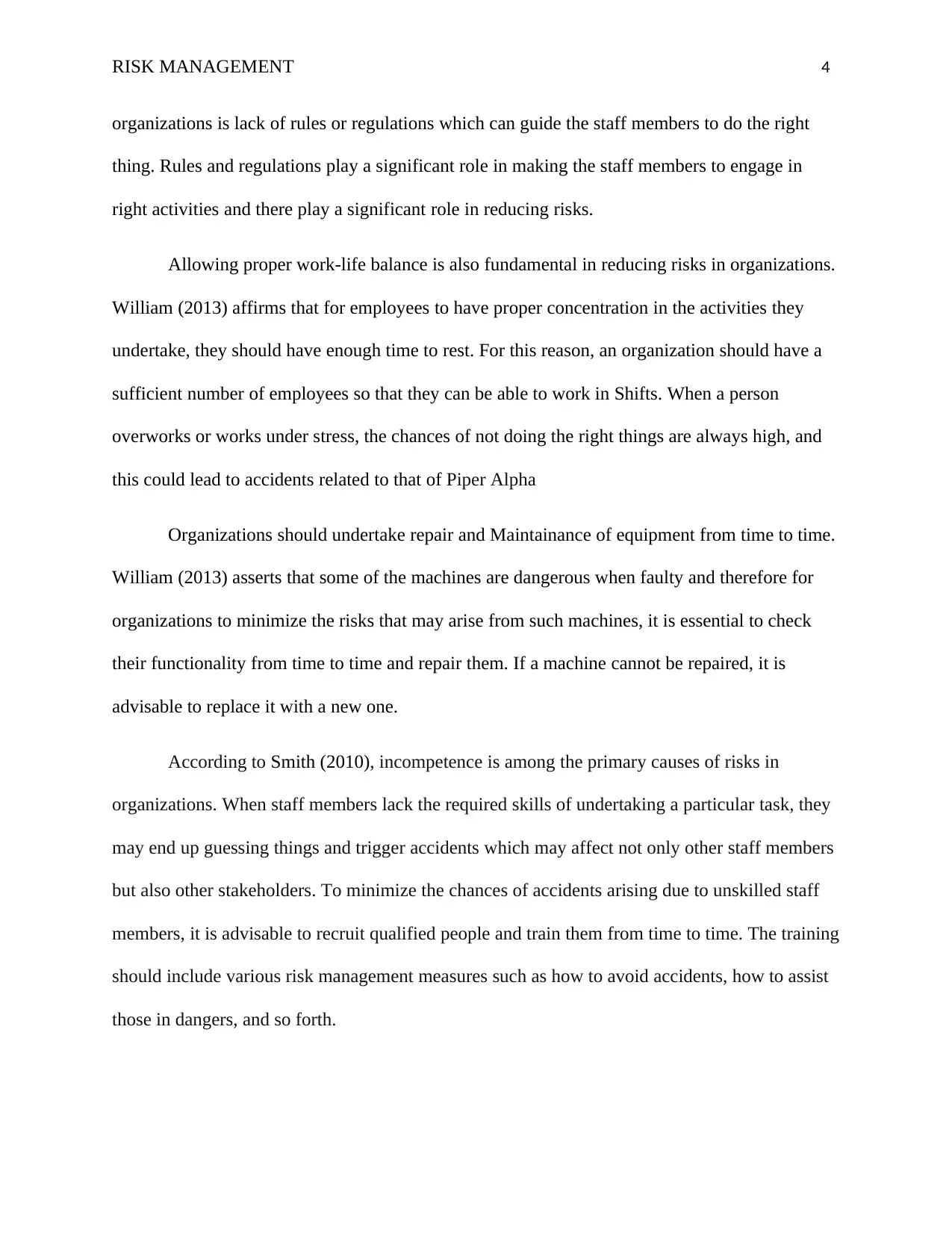
RISK MANAGEMENT 4
organizations is lack of rules or regulations which can guide the staff members to do the right
thing. Rules and regulations play a significant role in making the staff members to engage in
right activities and there play a significant role in reducing risks.
Allowing proper work-life balance is also fundamental in reducing risks in organizations.
William (2013) affirms that for employees to have proper concentration in the activities they
undertake, they should have enough time to rest. For this reason, an organization should have a
sufficient number of employees so that they can be able to work in Shifts. When a person
overworks or works under stress, the chances of not doing the right things are always high, and
this could lead to accidents related to that of Piper Alpha
Organizations should undertake repair and Maintainance of equipment from time to time.
William (2013) asserts that some of the machines are dangerous when faulty and therefore for
organizations to minimize the risks that may arise from such machines, it is essential to check
their functionality from time to time and repair them. If a machine cannot be repaired, it is
advisable to replace it with a new one.
According to Smith (2010), incompetence is among the primary causes of risks in
organizations. When staff members lack the required skills of undertaking a particular task, they
may end up guessing things and trigger accidents which may affect not only other staff members
but also other stakeholders. To minimize the chances of accidents arising due to unskilled staff
members, it is advisable to recruit qualified people and train them from time to time. The training
should include various risk management measures such as how to avoid accidents, how to assist
those in dangers, and so forth.
organizations is lack of rules or regulations which can guide the staff members to do the right
thing. Rules and regulations play a significant role in making the staff members to engage in
right activities and there play a significant role in reducing risks.
Allowing proper work-life balance is also fundamental in reducing risks in organizations.
William (2013) affirms that for employees to have proper concentration in the activities they
undertake, they should have enough time to rest. For this reason, an organization should have a
sufficient number of employees so that they can be able to work in Shifts. When a person
overworks or works under stress, the chances of not doing the right things are always high, and
this could lead to accidents related to that of Piper Alpha
Organizations should undertake repair and Maintainance of equipment from time to time.
William (2013) asserts that some of the machines are dangerous when faulty and therefore for
organizations to minimize the risks that may arise from such machines, it is essential to check
their functionality from time to time and repair them. If a machine cannot be repaired, it is
advisable to replace it with a new one.
According to Smith (2010), incompetence is among the primary causes of risks in
organizations. When staff members lack the required skills of undertaking a particular task, they
may end up guessing things and trigger accidents which may affect not only other staff members
but also other stakeholders. To minimize the chances of accidents arising due to unskilled staff
members, it is advisable to recruit qualified people and train them from time to time. The training
should include various risk management measures such as how to avoid accidents, how to assist
those in dangers, and so forth.
Paraphrase This Document
Need a fresh take? Get an instant paraphrase of this document with our AI Paraphraser
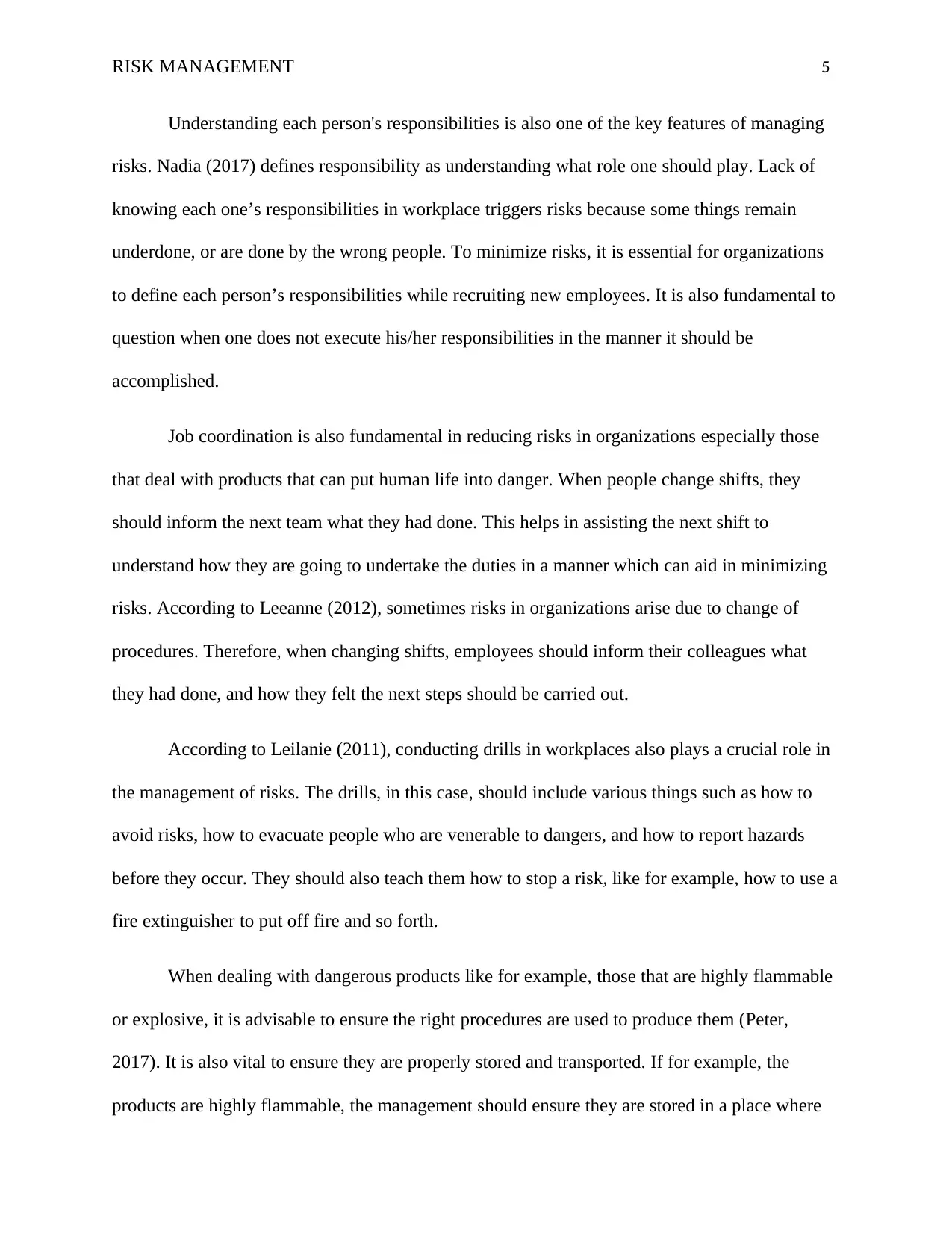
RISK MANAGEMENT 5
Understanding each person's responsibilities is also one of the key features of managing
risks. Nadia (2017) defines responsibility as understanding what role one should play. Lack of
knowing each one’s responsibilities in workplace triggers risks because some things remain
underdone, or are done by the wrong people. To minimize risks, it is essential for organizations
to define each person’s responsibilities while recruiting new employees. It is also fundamental to
question when one does not execute his/her responsibilities in the manner it should be
accomplished.
Job coordination is also fundamental in reducing risks in organizations especially those
that deal with products that can put human life into danger. When people change shifts, they
should inform the next team what they had done. This helps in assisting the next shift to
understand how they are going to undertake the duties in a manner which can aid in minimizing
risks. According to Leeanne (2012), sometimes risks in organizations arise due to change of
procedures. Therefore, when changing shifts, employees should inform their colleagues what
they had done, and how they felt the next steps should be carried out.
According to Leilanie (2011), conducting drills in workplaces also plays a crucial role in
the management of risks. The drills, in this case, should include various things such as how to
avoid risks, how to evacuate people who are venerable to dangers, and how to report hazards
before they occur. They should also teach them how to stop a risk, like for example, how to use a
fire extinguisher to put off fire and so forth.
When dealing with dangerous products like for example, those that are highly flammable
or explosive, it is advisable to ensure the right procedures are used to produce them (Peter,
2017). It is also vital to ensure they are properly stored and transported. If for example, the
products are highly flammable, the management should ensure they are stored in a place where
Understanding each person's responsibilities is also one of the key features of managing
risks. Nadia (2017) defines responsibility as understanding what role one should play. Lack of
knowing each one’s responsibilities in workplace triggers risks because some things remain
underdone, or are done by the wrong people. To minimize risks, it is essential for organizations
to define each person’s responsibilities while recruiting new employees. It is also fundamental to
question when one does not execute his/her responsibilities in the manner it should be
accomplished.
Job coordination is also fundamental in reducing risks in organizations especially those
that deal with products that can put human life into danger. When people change shifts, they
should inform the next team what they had done. This helps in assisting the next shift to
understand how they are going to undertake the duties in a manner which can aid in minimizing
risks. According to Leeanne (2012), sometimes risks in organizations arise due to change of
procedures. Therefore, when changing shifts, employees should inform their colleagues what
they had done, and how they felt the next steps should be carried out.
According to Leilanie (2011), conducting drills in workplaces also plays a crucial role in
the management of risks. The drills, in this case, should include various things such as how to
avoid risks, how to evacuate people who are venerable to dangers, and how to report hazards
before they occur. They should also teach them how to stop a risk, like for example, how to use a
fire extinguisher to put off fire and so forth.
When dealing with dangerous products like for example, those that are highly flammable
or explosive, it is advisable to ensure the right procedures are used to produce them (Peter,
2017). It is also vital to ensure they are properly stored and transported. If for example, the
products are highly flammable, the management should ensure they are stored in a place where

RISK MANAGEMENT 6
any form of ignition does not exist. Some of the accidents are caused due to negligence in
transportation and storage of products and therefore using this strategy in risk management can
play a significant role in ensuring no accident arises.
How its application may have prevented the Piper Alpha Oil & Gas Platform Explosion
in 1988
The alpha accident is one of the tragedies that would have been prevented if various
measures were put in place. This accident occurred in 1988 killing 167 people including two
crewmen of a rescue vessel. The reason that makes it right to argue that this accident would have
been prevented is that it was triggered by negligence.
If the discussed measures were put in place, this accident would not have occurred. For
example, if there were proper repair and regular checking of the equipment, this accident would
have been avoided. This is because one of the factors that triggered it is failing to tighten the nuts
to prevent leaking under pressure. If the management encouraged regular checking of the
machines and transportation equipment, this problem would have been identified and rectified.
Lack of proper repair and Maintainance was also the reason that made the occidental firefighting
vessel Tharos to fail not function in the right manner. If it was in the right condition, it would
have functioned without being restarted from time to time.
Using proper work-life balance would have also played a role in minimizing accidents in
this company (Hampton, 2015). Letting the products to be handled by people who had worked
for long hours was not advisable because they were hazardous to not only human beings but also
to aquatic life. When one is tired, concentration to tasks becomes low, and this may make the
person do things that may result in accidents.
any form of ignition does not exist. Some of the accidents are caused due to negligence in
transportation and storage of products and therefore using this strategy in risk management can
play a significant role in ensuring no accident arises.
How its application may have prevented the Piper Alpha Oil & Gas Platform Explosion
in 1988
The alpha accident is one of the tragedies that would have been prevented if various
measures were put in place. This accident occurred in 1988 killing 167 people including two
crewmen of a rescue vessel. The reason that makes it right to argue that this accident would have
been prevented is that it was triggered by negligence.
If the discussed measures were put in place, this accident would not have occurred. For
example, if there were proper repair and regular checking of the equipment, this accident would
have been avoided. This is because one of the factors that triggered it is failing to tighten the nuts
to prevent leaking under pressure. If the management encouraged regular checking of the
machines and transportation equipment, this problem would have been identified and rectified.
Lack of proper repair and Maintainance was also the reason that made the occidental firefighting
vessel Tharos to fail not function in the right manner. If it was in the right condition, it would
have functioned without being restarted from time to time.
Using proper work-life balance would have also played a role in minimizing accidents in
this company (Hampton, 2015). Letting the products to be handled by people who had worked
for long hours was not advisable because they were hazardous to not only human beings but also
to aquatic life. When one is tired, concentration to tasks becomes low, and this may make the
person do things that may result in accidents.
⊘ This is a preview!⊘
Do you want full access?
Subscribe today to unlock all pages.

Trusted by 1+ million students worldwide
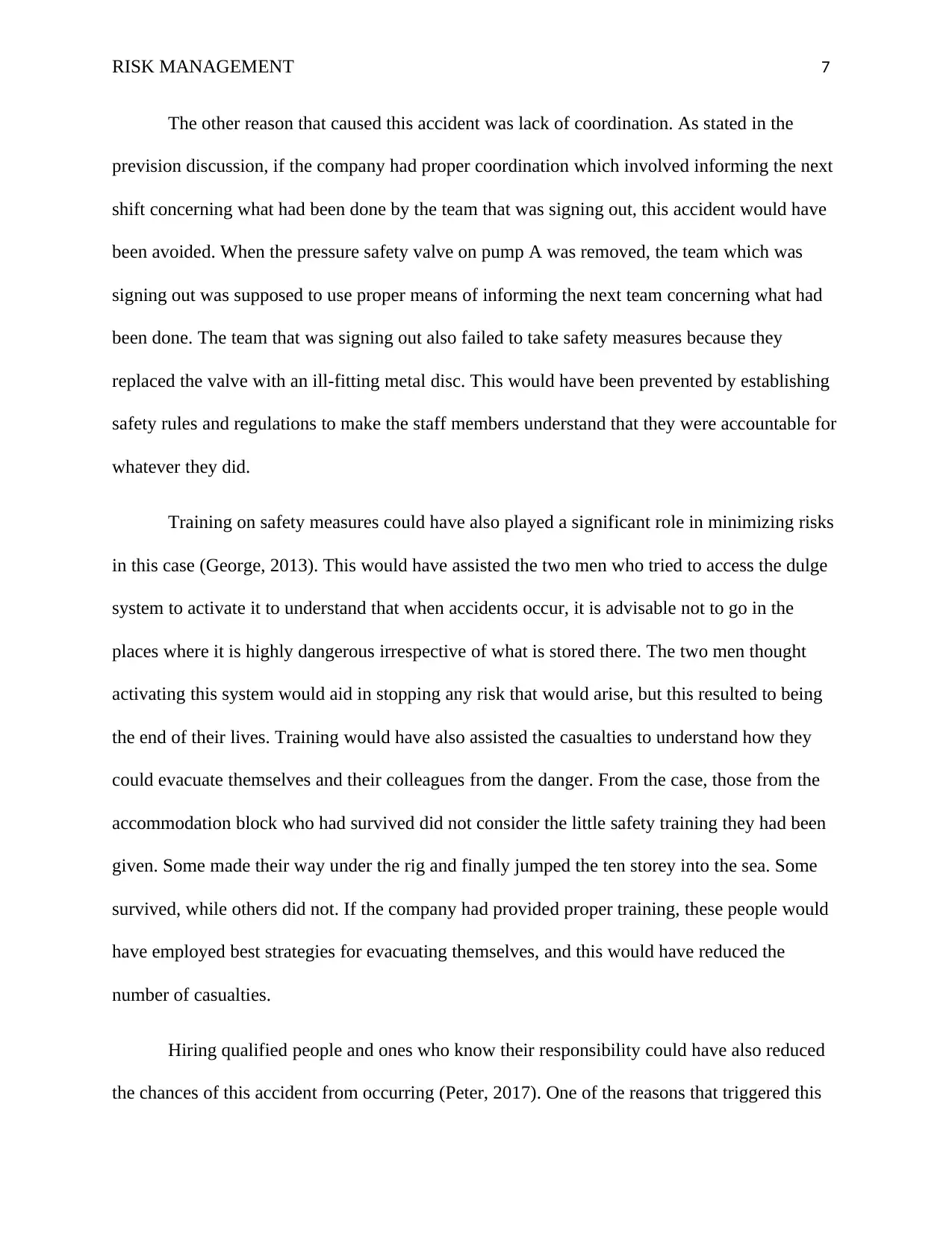
RISK MANAGEMENT 7
The other reason that caused this accident was lack of coordination. As stated in the
prevision discussion, if the company had proper coordination which involved informing the next
shift concerning what had been done by the team that was signing out, this accident would have
been avoided. When the pressure safety valve on pump A was removed, the team which was
signing out was supposed to use proper means of informing the next team concerning what had
been done. The team that was signing out also failed to take safety measures because they
replaced the valve with an ill-fitting metal disc. This would have been prevented by establishing
safety rules and regulations to make the staff members understand that they were accountable for
whatever they did.
Training on safety measures could have also played a significant role in minimizing risks
in this case (George, 2013). This would have assisted the two men who tried to access the dulge
system to activate it to understand that when accidents occur, it is advisable not to go in the
places where it is highly dangerous irrespective of what is stored there. The two men thought
activating this system would aid in stopping any risk that would arise, but this resulted to being
the end of their lives. Training would have also assisted the casualties to understand how they
could evacuate themselves and their colleagues from the danger. From the case, those from the
accommodation block who had survived did not consider the little safety training they had been
given. Some made their way under the rig and finally jumped the ten storey into the sea. Some
survived, while others did not. If the company had provided proper training, these people would
have employed best strategies for evacuating themselves, and this would have reduced the
number of casualties.
Hiring qualified people and ones who know their responsibility could have also reduced
the chances of this accident from occurring (Peter, 2017). One of the reasons that triggered this
The other reason that caused this accident was lack of coordination. As stated in the
prevision discussion, if the company had proper coordination which involved informing the next
shift concerning what had been done by the team that was signing out, this accident would have
been avoided. When the pressure safety valve on pump A was removed, the team which was
signing out was supposed to use proper means of informing the next team concerning what had
been done. The team that was signing out also failed to take safety measures because they
replaced the valve with an ill-fitting metal disc. This would have been prevented by establishing
safety rules and regulations to make the staff members understand that they were accountable for
whatever they did.
Training on safety measures could have also played a significant role in minimizing risks
in this case (George, 2013). This would have assisted the two men who tried to access the dulge
system to activate it to understand that when accidents occur, it is advisable not to go in the
places where it is highly dangerous irrespective of what is stored there. The two men thought
activating this system would aid in stopping any risk that would arise, but this resulted to being
the end of their lives. Training would have also assisted the casualties to understand how they
could evacuate themselves and their colleagues from the danger. From the case, those from the
accommodation block who had survived did not consider the little safety training they had been
given. Some made their way under the rig and finally jumped the ten storey into the sea. Some
survived, while others did not. If the company had provided proper training, these people would
have employed best strategies for evacuating themselves, and this would have reduced the
number of casualties.
Hiring qualified people and ones who know their responsibility could have also reduced
the chances of this accident from occurring (Peter, 2017). One of the reasons that triggered this
Paraphrase This Document
Need a fresh take? Get an instant paraphrase of this document with our AI Paraphraser
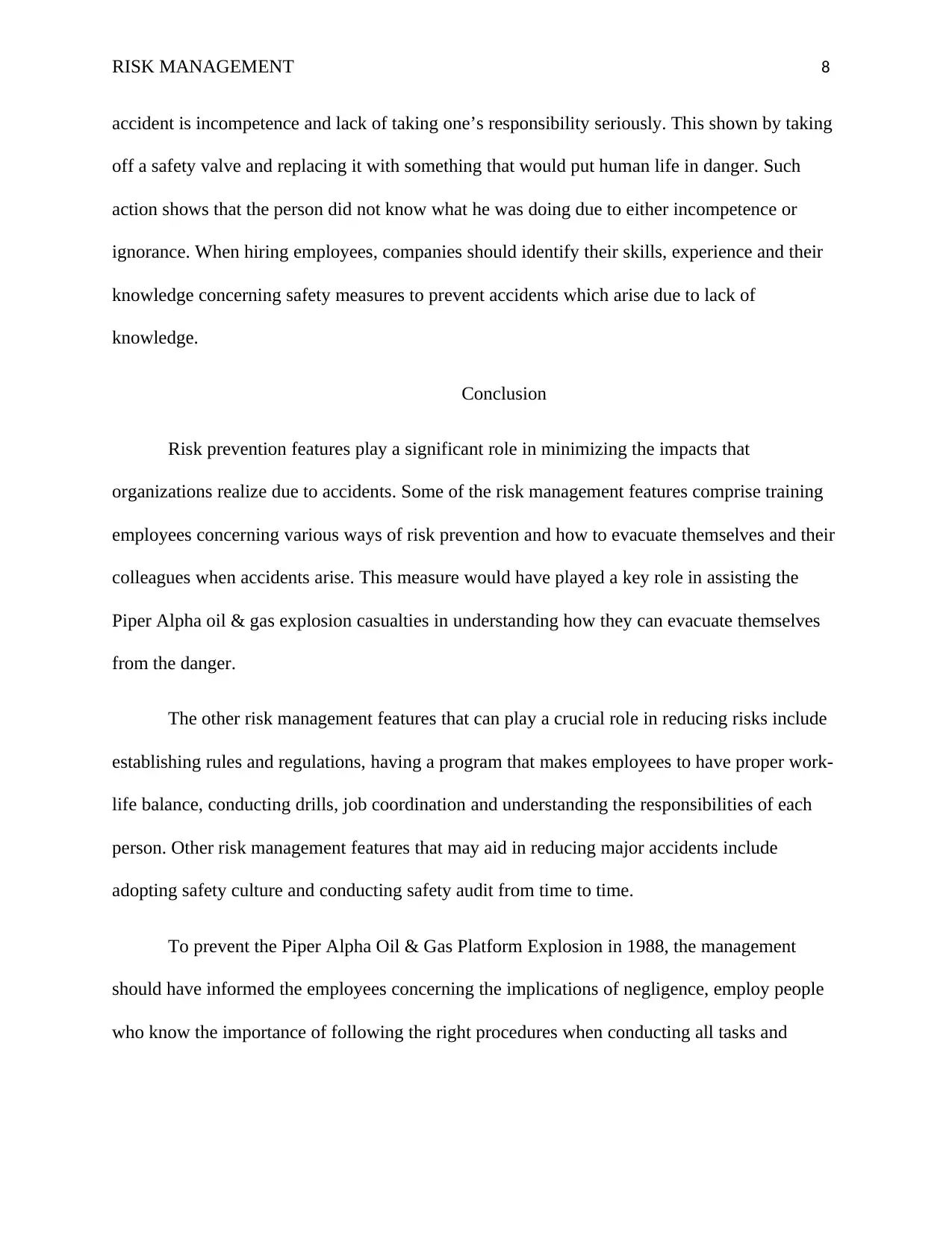
RISK MANAGEMENT 8
accident is incompetence and lack of taking one’s responsibility seriously. This shown by taking
off a safety valve and replacing it with something that would put human life in danger. Such
action shows that the person did not know what he was doing due to either incompetence or
ignorance. When hiring employees, companies should identify their skills, experience and their
knowledge concerning safety measures to prevent accidents which arise due to lack of
knowledge.
Conclusion
Risk prevention features play a significant role in minimizing the impacts that
organizations realize due to accidents. Some of the risk management features comprise training
employees concerning various ways of risk prevention and how to evacuate themselves and their
colleagues when accidents arise. This measure would have played a key role in assisting the
Piper Alpha oil & gas explosion casualties in understanding how they can evacuate themselves
from the danger.
The other risk management features that can play a crucial role in reducing risks include
establishing rules and regulations, having a program that makes employees to have proper work-
life balance, conducting drills, job coordination and understanding the responsibilities of each
person. Other risk management features that may aid in reducing major accidents include
adopting safety culture and conducting safety audit from time to time.
To prevent the Piper Alpha Oil & Gas Platform Explosion in 1988, the management
should have informed the employees concerning the implications of negligence, employ people
who know the importance of following the right procedures when conducting all tasks and
accident is incompetence and lack of taking one’s responsibility seriously. This shown by taking
off a safety valve and replacing it with something that would put human life in danger. Such
action shows that the person did not know what he was doing due to either incompetence or
ignorance. When hiring employees, companies should identify their skills, experience and their
knowledge concerning safety measures to prevent accidents which arise due to lack of
knowledge.
Conclusion
Risk prevention features play a significant role in minimizing the impacts that
organizations realize due to accidents. Some of the risk management features comprise training
employees concerning various ways of risk prevention and how to evacuate themselves and their
colleagues when accidents arise. This measure would have played a key role in assisting the
Piper Alpha oil & gas explosion casualties in understanding how they can evacuate themselves
from the danger.
The other risk management features that can play a crucial role in reducing risks include
establishing rules and regulations, having a program that makes employees to have proper work-
life balance, conducting drills, job coordination and understanding the responsibilities of each
person. Other risk management features that may aid in reducing major accidents include
adopting safety culture and conducting safety audit from time to time.
To prevent the Piper Alpha Oil & Gas Platform Explosion in 1988, the management
should have informed the employees concerning the implications of negligence, employ people
who know the importance of following the right procedures when conducting all tasks and

RISK MANAGEMENT 9
repairing machines from time to time. The company would have also prevented this accident by
fostering proper coordination and communication.
repairing machines from time to time. The company would have also prevented this accident by
fostering proper coordination and communication.
⊘ This is a preview!⊘
Do you want full access?
Subscribe today to unlock all pages.

Trusted by 1+ million students worldwide
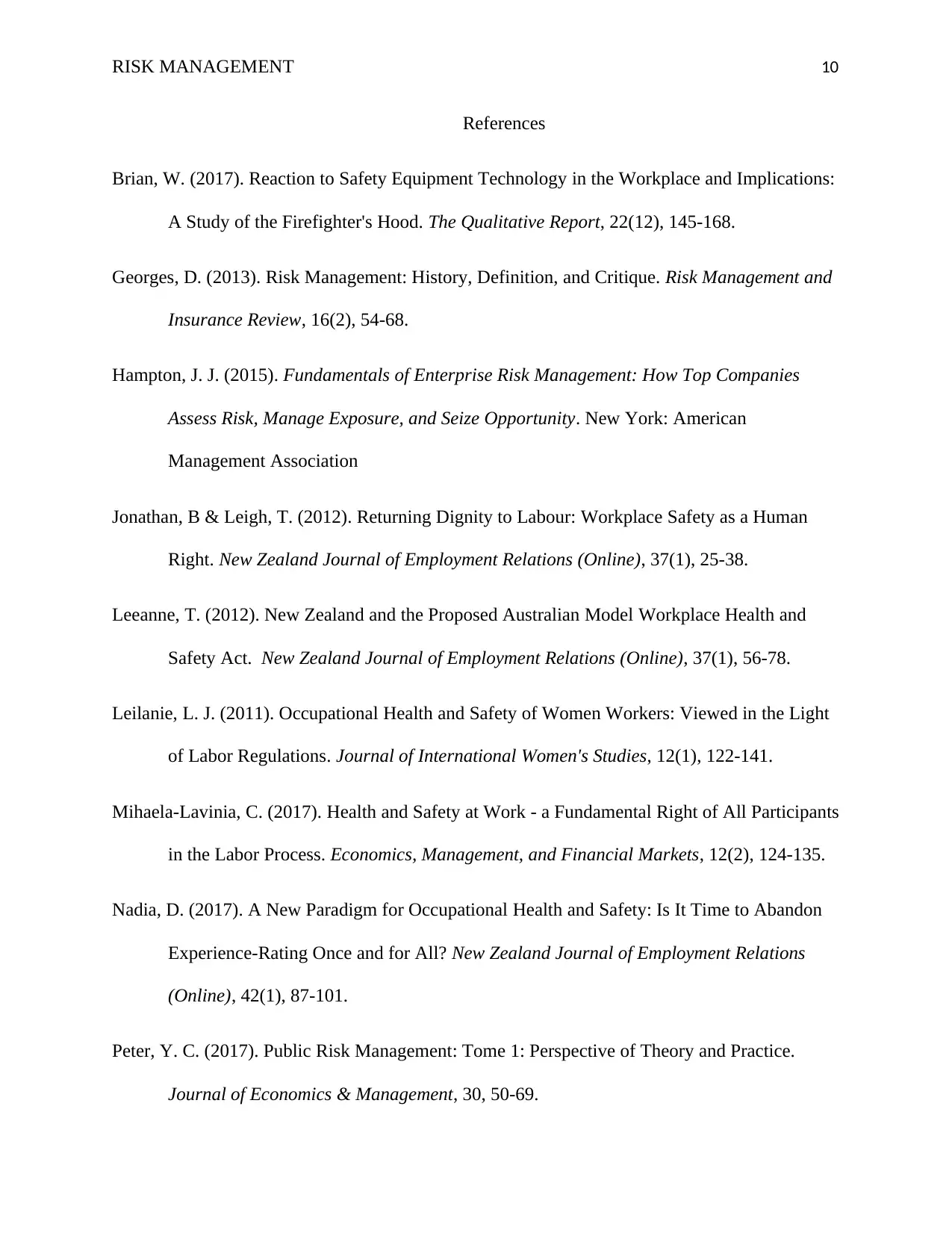
RISK MANAGEMENT 10
References
Brian, W. (2017). Reaction to Safety Equipment Technology in the Workplace and Implications:
A Study of the Firefighter's Hood. The Qualitative Report, 22(12), 145-168.
Georges, D. (2013). Risk Management: History, Definition, and Critique. Risk Management and
Insurance Review, 16(2), 54-68.
Hampton, J. J. (2015). Fundamentals of Enterprise Risk Management: How Top Companies
Assess Risk, Manage Exposure, and Seize Opportunity. New York: American
Management Association
Jonathan, B & Leigh, T. (2012). Returning Dignity to Labour: Workplace Safety as a Human
Right. New Zealand Journal of Employment Relations (Online), 37(1), 25-38.
Leeanne, T. (2012). New Zealand and the Proposed Australian Model Workplace Health and
Safety Act. New Zealand Journal of Employment Relations (Online), 37(1), 56-78.
Leilanie, L. J. (2011). Occupational Health and Safety of Women Workers: Viewed in the Light
of Labor Regulations. Journal of International Women's Studies, 12(1), 122-141.
Mihaela-Lavinia, C. (2017). Health and Safety at Work - a Fundamental Right of All Participants
in the Labor Process. Economics, Management, and Financial Markets, 12(2), 124-135.
Nadia, D. (2017). A New Paradigm for Occupational Health and Safety: Is It Time to Abandon
Experience-Rating Once and for All? New Zealand Journal of Employment Relations
(Online), 42(1), 87-101.
Peter, Y. C. (2017). Public Risk Management: Tome 1: Perspective of Theory and Practice.
Journal of Economics & Management, 30, 50-69.
References
Brian, W. (2017). Reaction to Safety Equipment Technology in the Workplace and Implications:
A Study of the Firefighter's Hood. The Qualitative Report, 22(12), 145-168.
Georges, D. (2013). Risk Management: History, Definition, and Critique. Risk Management and
Insurance Review, 16(2), 54-68.
Hampton, J. J. (2015). Fundamentals of Enterprise Risk Management: How Top Companies
Assess Risk, Manage Exposure, and Seize Opportunity. New York: American
Management Association
Jonathan, B & Leigh, T. (2012). Returning Dignity to Labour: Workplace Safety as a Human
Right. New Zealand Journal of Employment Relations (Online), 37(1), 25-38.
Leeanne, T. (2012). New Zealand and the Proposed Australian Model Workplace Health and
Safety Act. New Zealand Journal of Employment Relations (Online), 37(1), 56-78.
Leilanie, L. J. (2011). Occupational Health and Safety of Women Workers: Viewed in the Light
of Labor Regulations. Journal of International Women's Studies, 12(1), 122-141.
Mihaela-Lavinia, C. (2017). Health and Safety at Work - a Fundamental Right of All Participants
in the Labor Process. Economics, Management, and Financial Markets, 12(2), 124-135.
Nadia, D. (2017). A New Paradigm for Occupational Health and Safety: Is It Time to Abandon
Experience-Rating Once and for All? New Zealand Journal of Employment Relations
(Online), 42(1), 87-101.
Peter, Y. C. (2017). Public Risk Management: Tome 1: Perspective of Theory and Practice.
Journal of Economics & Management, 30, 50-69.
Paraphrase This Document
Need a fresh take? Get an instant paraphrase of this document with our AI Paraphraser
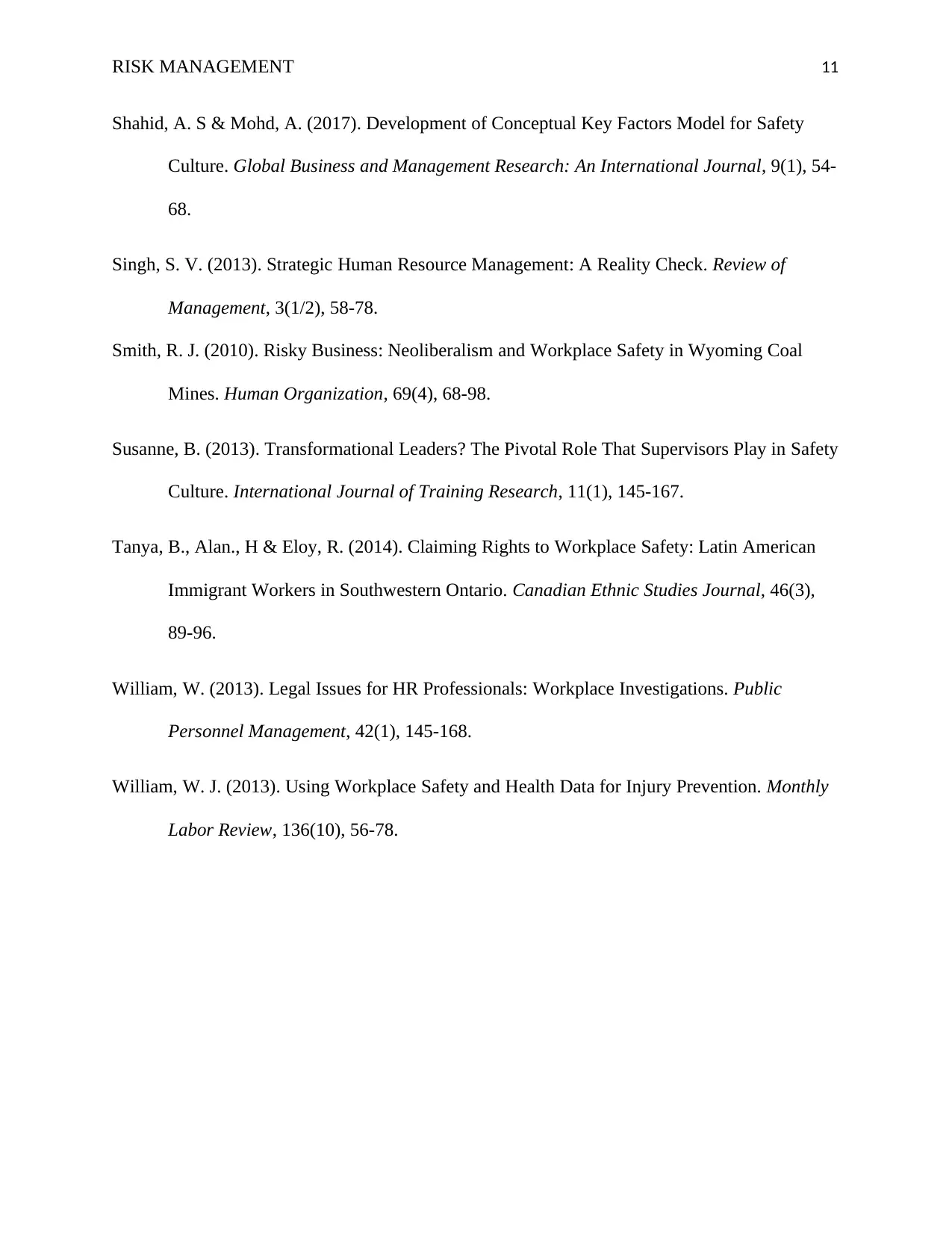
RISK MANAGEMENT 11
Shahid, A. S & Mohd, A. (2017). Development of Conceptual Key Factors Model for Safety
Culture. Global Business and Management Research: An International Journal, 9(1), 54-
68.
Singh, S. V. (2013). Strategic Human Resource Management: A Reality Check. Review of
Management, 3(1/2), 58-78.
Smith, R. J. (2010). Risky Business: Neoliberalism and Workplace Safety in Wyoming Coal
Mines. Human Organization, 69(4), 68-98.
Susanne, B. (2013). Transformational Leaders? The Pivotal Role That Supervisors Play in Safety
Culture. International Journal of Training Research, 11(1), 145-167.
Tanya, B., Alan., H & Eloy, R. (2014). Claiming Rights to Workplace Safety: Latin American
Immigrant Workers in Southwestern Ontario. Canadian Ethnic Studies Journal, 46(3),
89-96.
William, W. (2013). Legal Issues for HR Professionals: Workplace Investigations. Public
Personnel Management, 42(1), 145-168.
William, W. J. (2013). Using Workplace Safety and Health Data for Injury Prevention. Monthly
Labor Review, 136(10), 56-78.
Shahid, A. S & Mohd, A. (2017). Development of Conceptual Key Factors Model for Safety
Culture. Global Business and Management Research: An International Journal, 9(1), 54-
68.
Singh, S. V. (2013). Strategic Human Resource Management: A Reality Check. Review of
Management, 3(1/2), 58-78.
Smith, R. J. (2010). Risky Business: Neoliberalism and Workplace Safety in Wyoming Coal
Mines. Human Organization, 69(4), 68-98.
Susanne, B. (2013). Transformational Leaders? The Pivotal Role That Supervisors Play in Safety
Culture. International Journal of Training Research, 11(1), 145-167.
Tanya, B., Alan., H & Eloy, R. (2014). Claiming Rights to Workplace Safety: Latin American
Immigrant Workers in Southwestern Ontario. Canadian Ethnic Studies Journal, 46(3),
89-96.
William, W. (2013). Legal Issues for HR Professionals: Workplace Investigations. Public
Personnel Management, 42(1), 145-168.
William, W. J. (2013). Using Workplace Safety and Health Data for Injury Prevention. Monthly
Labor Review, 136(10), 56-78.
1 out of 11
Related Documents
Your All-in-One AI-Powered Toolkit for Academic Success.
+13062052269
info@desklib.com
Available 24*7 on WhatsApp / Email
![[object Object]](/_next/static/media/star-bottom.7253800d.svg)
Unlock your academic potential
Copyright © 2020–2025 A2Z Services. All Rights Reserved. Developed and managed by ZUCOL.





